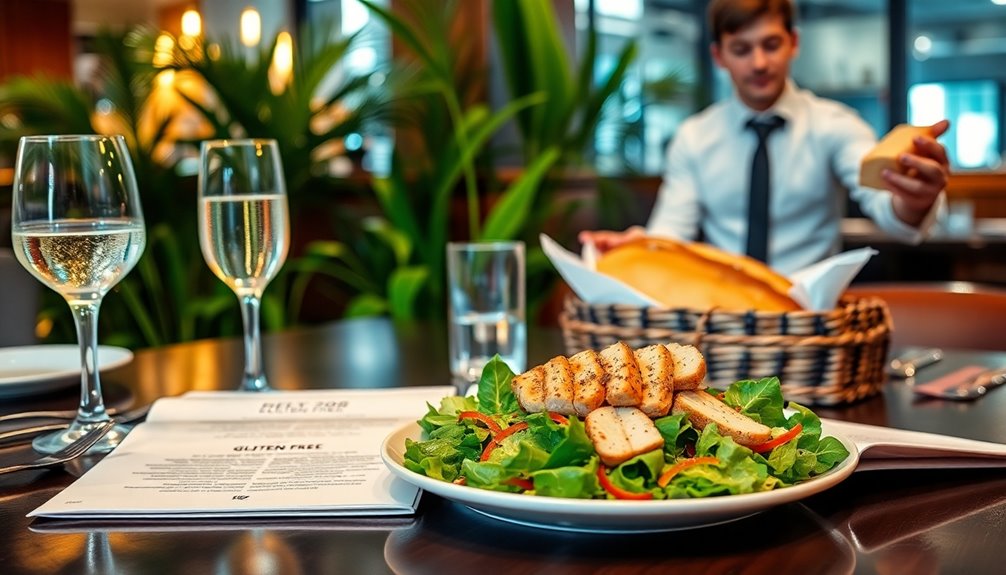When dining out gluten-free, start by researching restaurants that offer gluten-free options. Communicate your dietary needs clearly to the staff and ask about cross-contamination prevention. Always review the menu in advance to streamline your choices, focusing on simple dishes like grilled proteins or salads. Be cautious of sauces and dressings, as they may contain hidden gluten. Trust your instincts; if something feels off, don't hesitate to ask for clarification. Sharing your experiences can also help others in your community. You'll find even more tips and strategies to navigate your dining adventures successfully.
Key Takeaways
- Research and compile a list of gluten-free-friendly restaurants, checking reviews and menus for suitable options.
- Clearly communicate your gluten allergy to restaurant staff and inquire about gluten-free menu items.
- Ask about cross-contamination prevention and dedicated preparation areas for gluten-free dishes.
- Review the menu in advance to identify gluten-free options and choose simple, safe dishes.
- Share your dining experiences to help raise awareness and support the gluten-free community.
Research Gluten-Free Friendly Restaurants
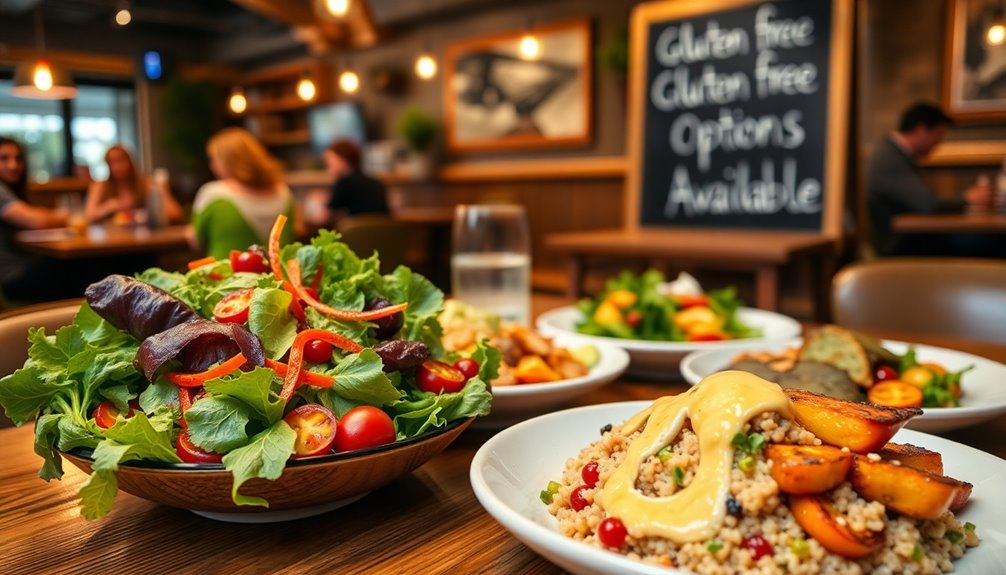
Finding gluten-free friendly restaurants is crucial for anyone looking to maintain a gluten-free diet while dining out. You want to enjoy your meal without worrying about gluten contamination, and knowing which places offer safe options can make all the difference.
Start by researching local favorites that cater specifically to gluten-free diners. Many communities have hidden gems that serve delicious meals while prioritizing your dietary needs.
Online resources such as dedicated gluten-free restaurant finders or apps can help you discover nearby establishments that provide gluten-free menus or options. Don't forget to check out reviews from others who follow a gluten-free diet; their experiences can guide you in choosing a spot that meets your standards. Additionally, local social media groups or forums can be invaluable for gathering recommendations from people who share your dietary restrictions.
When you identify restaurants that seem promising, take a moment to explore their menus online. Look for dishes marked as gluten-free or inquire about how they handle cross-contamination. This additional step not only guarantees you have safe options but also shows restaurant staff that you're serious about your dietary needs.
Lastly, consider making a list of your go-to gluten-free spots. You'll build a repertoire of local favorites that you can confidently visit and enjoy with friends or family. By doing your research, you can dine out with peace of mind, knowing you've chosen places that truly respect your gluten-free lifestyle.
Communicate Your Needs Clearly
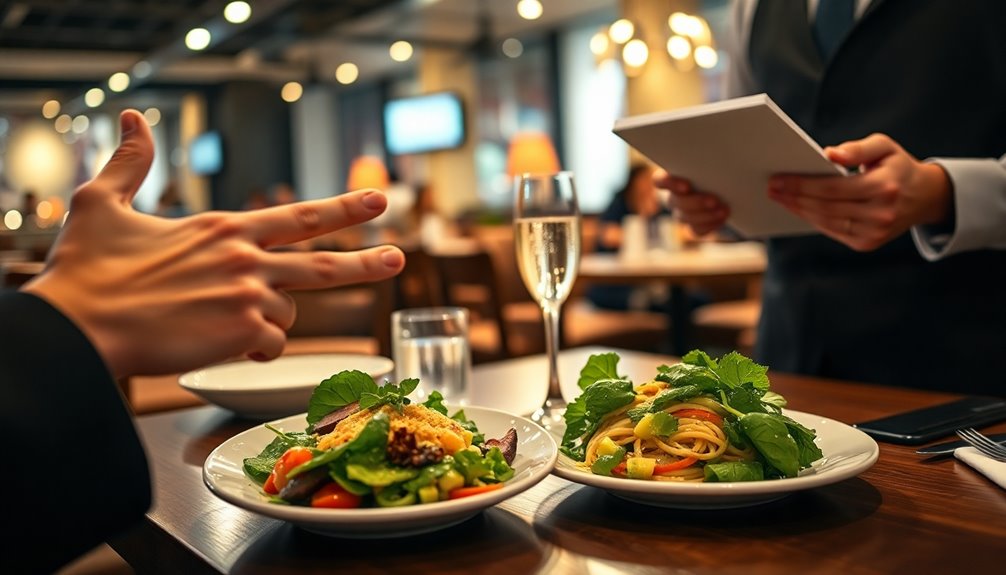
When dining out, clearly expressing your gluten-free requirements to restaurant staff is crucial for a safe and pleasant experience. To ensure everyone is on the same page, use polite and direct language. This not only aligns with dining etiquette but also fosters a sense of belonging in the dining community.
Here's a simple guide to help you communicate effectively:
| What to Say | Why It Matters | Example Phrase |
|---|---|---|
| Specify your dietary needs | It helps the staff grasp your restrictions. | "I have a gluten allergy." |
| Ask about menu options | It shows you're engaged and proactive. | "Can you suggest gluten-free dishes?" |
| Confirm preparation methods | It guarantees your meal is safe from cross-contamination. | "How is this dish made?" |
By clearly stating your needs, you're laying a foundation for positive interactions. Many restaurant reviews highlight the significance of staff responsiveness to dietary restrictions. When you express your needs, you're not only advocating for yourself but also paving the way for others in the gluten-free community. Additionally, being aware of the health dangers of traditional bread can help you make informed choices at restaurants.
Remember to be courteous and patient; kitchen staff often handle various dietary requests. Your clear communication can enhance their ability to serve you safely. Ultimately, a little clarity goes a long way in making your dining experience enjoyable, allowing you to relish the moment without worry.
Ask About Cross-Contamination
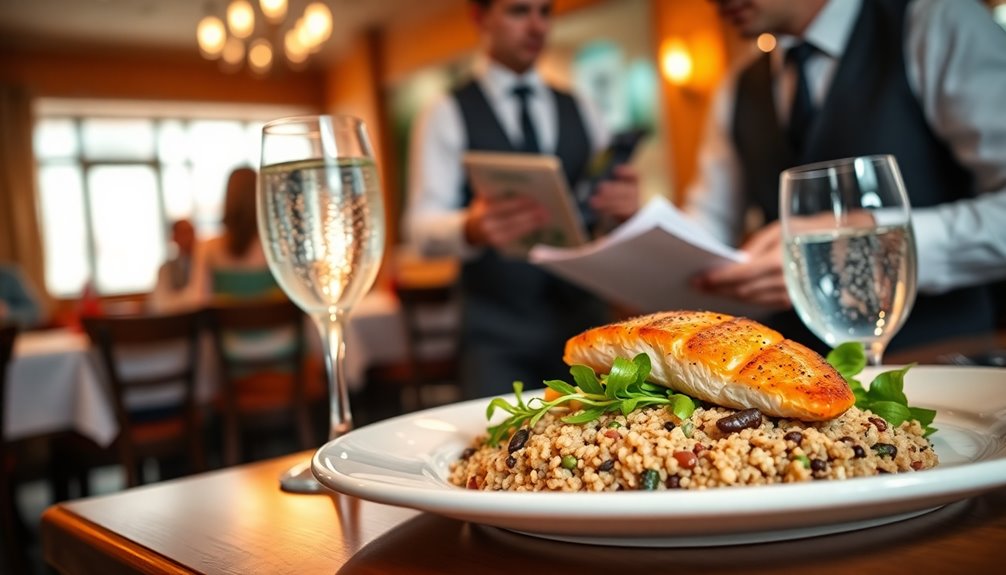
After clearly communicating your gluten-free needs, the next important step is to inquire about cross-contamination in the kitchen. Cross-contamination concerns are important for anyone with celiac disease or gluten sensitivity. Even tiny traces of gluten can trigger adverse reactions, so it's essential to make sure that your meal is prepared safely.
When you're at a restaurant, don't hesitate to ask specific questions. For instance, inquire whether the staff uses separate utensils and cookware for gluten-free foods.
You might also want to know if they've dedicated areas for preparing gluten-free dishes. If a restaurant doesn't have clear protocols in place, it's a red flag.
It's also helpful to ask about the ingredients in sauces, dressings, or marinades, as these can often contain hidden gluten. Many restaurants are more than willing to provide safe options if you simply ask.
A plant-based diet can also be beneficial since it often includes low-gluten options that help ensure your meals are safe and enjoyable.
Don't feel shy about requesting modifications to your meal, such as preparing your dish without croutons or sauces that may contain gluten.
Review the Menu in Advance
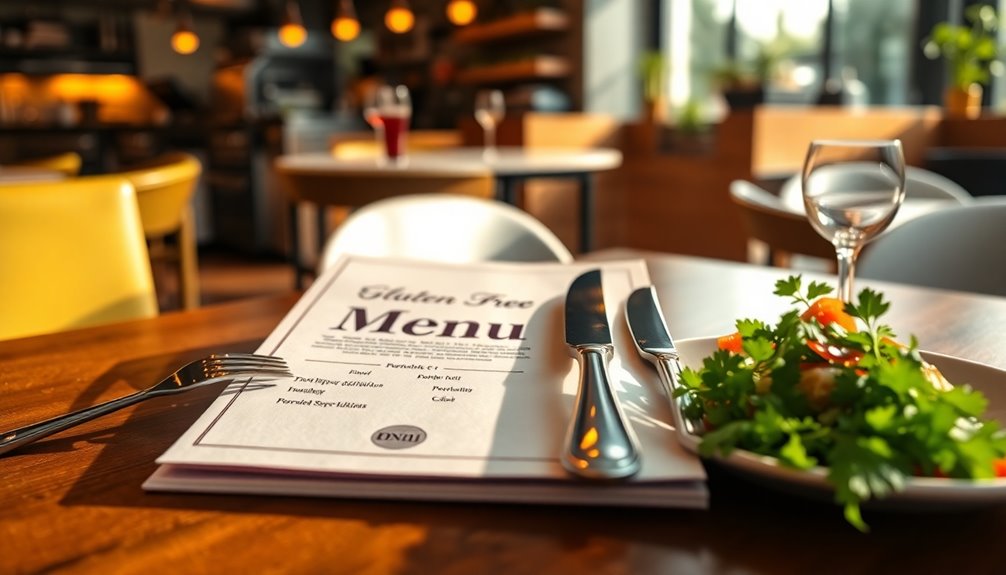
Reviewing the menu in advance can greatly enhance your dining experience while staying gluten-free. By conducting a thorough menu analysis, you'll save time and reduce stress when you arrive at the restaurant. Familiarizing yourself with the options allows you to identify dishes that are naturally gluten-free or can be modified to meet your dietary needs.
Start by checking the restaurant's website or popular review platforms. Many eateries post their menus online, giving you the chance to explore your choices ahead of time. Look for symbols or notes indicating gluten-free options; some restaurants highlight these to make your decision easier.
If the menu isn't available online, consider searching for online reviews. Other diners often share their experiences regarding gluten-free meals, which can provide valuable insights into what to order and what to avoid.
When you analyze the menu, take note of ingredients and preparation methods. Some dishes may contain gluten or be prepared in ways that could lead to cross-contamination, even if they seem safe at first glance. If you find a dish that interests you, jot down any questions you might've about its preparation or ingredients. This way, you can ask the staff for clarification when you arrive.
Being proactive about reviewing the menu not only empowers you but also fosters a sense of belonging within your dining group, as you'll contribute to choosing a restaurant that accommodates everyone's needs. Additionally, consider the importance of meal planning as it can help in identifying gluten-free options effectively.
Choose Simple Dishes

Choosing simple dishes is a smart strategy for browsing menus while maintaining a gluten-free diet. When you opt for straightforward meals, you can better control your ingredient analysis and minimize the risk of hidden gluten. Simple dishes often consist of whole foods that are less likely to contain gluten-containing additives or sauces.
Consider these tips when choosing your meals:
- Grilled proteins: Items like chicken, fish, or steak are usually gluten-free and packed with nutrients.
- Fresh salads: Opt for salads with basic greens, veggies, and a simple dressing, avoiding croutons or complex toppings.
- Steamed vegetables: These are healthy, gluten-free, and can accompany almost any main dish.
- Rice or quinoa: As gluten-free grains, these can provide a satisfying base for your meal without the gluten concerns.
- Soups with clear broth: Stick to broths that are made from scratch, ensuring they aren't thickened with flour.
Portion control is also key when enjoying simple dishes. By focusing on balanced meals, you can better manage how much you eat while still feeling satisfied. This approach not only helps with your gluten-free needs but also promotes overall healthy eating habits. Additionally, incorporating keto diet benefits can further enhance your dietary choices while dining out.
Opt for Gluten-Free Alternatives

When dining out, many restaurants now offer gluten-free alternatives to popular dishes, making it simpler to stick to your dietary needs without compromising on taste. These alternatives can include gluten-free pasta, pizza crusts, and even desserts. By choosing these dishes, you can relish a satisfying meal while managing your gluten intolerance.
When you opt for gluten-free options, it's crucial to verify that the restaurant is well-informed about cross-contamination. Many places take this seriously and will prepare your meal with separate utensils and cooking surfaces. Don't hesitate to ask questions; it demonstrates that you prioritize your health and contributes to a safer dining experience.
While you might love cooking at home, dining out can sometimes offer a pleasant change of pace. Discovering restaurants that cater to gluten-free diets can nurture a sense of belonging within your community. It's comforting to know that you're not alone in your dietary journey, as many individuals are facing similar challenges.
When choosing a restaurant, consider those that specialize in gluten-free cuisines or have a strong reputation for accommodating dietary restrictions. This not only enriches your dining experience but also supports establishments that value inclusivity.
Be Wary of Sauces and Dressings
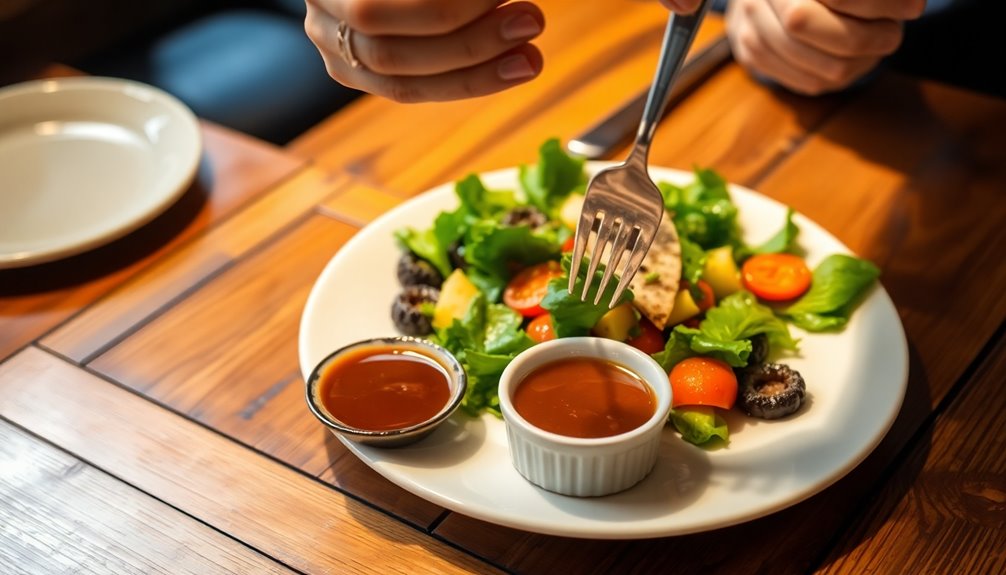
Many sauces and dressings can contain hidden gluten, making it essential to scrutinize these components when dining out. It's easy to assume that a dish is gluten-free just because it looks innocent. However, many popular sauces are thickened with wheat-based ingredients or include soy sauce, which often contains gluten.
To help you navigate this tricky terrain, here are some tips to keep in mind:
- Ask about ingredients: Don't hesitate to ask your server about the specific ingredients in sauces and dressings.
- Request gluten-free substitutes: Many restaurants now offer gluten-free alternatives for common sauces. Be sure to inquire about these options.
- Watch for cross-contamination: Even gluten-free sauces can be contaminated during preparation. It's worth asking how the kitchen handles this.
- Be cautious with condiments: Items like ketchup, mustard, and marinades can also harbor hidden gluten. Always check labels or ask.
- Read the menu carefully: Many restaurants provide details about allergens. Look for those notes to guide your choices.
Additionally, many sauces may contain hidden gluten sources that are not immediately obvious, so it's crucial to stay informed about what to avoid.
Trust Your Instincts
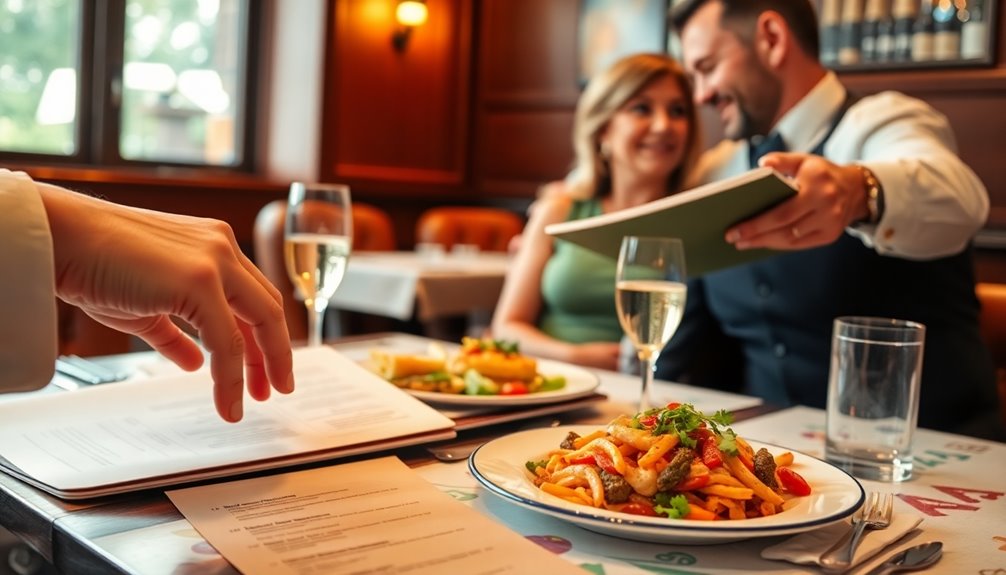
Even with careful scrutiny of sauces and dressings, trusting your instincts can be a powerful tool when eating out gluten-free. Intuition awareness is essential; if something feels off about a dish or the way it's prepared, don't hesitate to ask questions. Your ability to advocate for yourself is pivotal in ensuring your meal meets your dietary needs.
When you browse the menu, take a moment to reflect on what you know about gluten-containing ingredients. If a dish includes certain sauces or grains that raise a red flag, use ingredient questioning to clarify. Politely ask your server about specific components or how a dish is prepared. A good restaurant will appreciate your diligence and want to assist you.
Additionally, menu clarification goes beyond just asking about ingredients. If the description seems vague, don't shy away from seeking more details. You deserve to feel confident about what you're ordering. Trusting your instincts might lead you to opt for a dish that feels safer or even to request modifications if necessary. Remember, embracing natural calorie cycles can also support your overall health while enjoying dining out.
Share Your Experience With Others
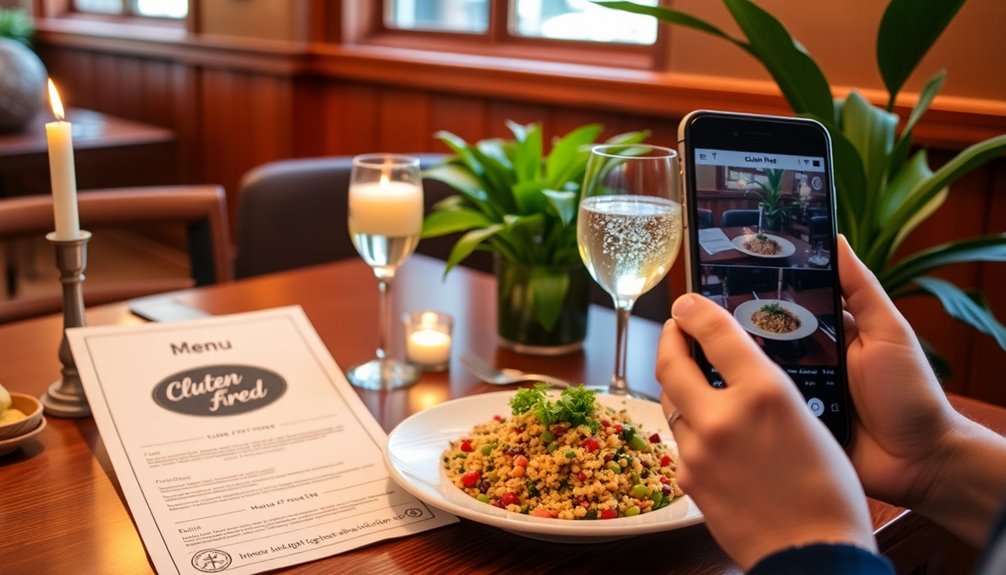
Sharing your experiences with gluten-free dining can be incredibly beneficial, not just for yourself but for others facing similar dietary restrictions. When you share your journey, you create a sense of community and support that's invaluable. It's not just about exploring menus; it's about connecting with those who understand your challenges and victories.
Here are some ways to share your experiences effectively:
- Blog or Social Media: Document your dining adventures! Share photos, reviews, and tips about gluten-free restaurants you've tried.
- Recipe Swaps: Exchange your favorite gluten-free recipes with friends or online groups. This can inspire others and expand your own culinary repertoire.
- Local Support Groups: Join or create a group focused on gluten-free living. Sharing stories in person can foster deeper connections.
- Dining Reviews: Write reviews on platforms like Yelp or Google. Your insights can help others make informed dining choices.
- Host Events: Organize gluten-free potlucks where everyone brings their favorite dish. It's a fun way to explore new recipes and enjoy community. Additionally, sharing your experience can encourage others to explore plant-based diets, which offer numerous health benefits and can complement a gluten-free lifestyle.
Frequently Asked Questions
Are All Gluten-Free Labeled Foods Safe for Celiac Disease?
Not all gluten-free labeled foods are safe for celiac disease. While gluten-free certifications can indicate a product's safety, cross-contamination risks can still occur during production or preparation. Ensuring to check for trusted certifications and read labels carefully. When uncertain, contact manufacturers for clarification. By staying informed, you can better navigate your dietary choices and enjoy safe, gluten-free options without worry.
How Can I Handle Social Pressure When Eating Out?
Managing social pressure while eating out can feel like you're walking a tightrope, but it doesn't have to be that way. Start by confidently discussing your dietary needs with friends; most will appreciate your honesty.
When you're maneuvering menus, ask for peer support—your friends can help advocate for you.
What Should I Do if I Accidentally Consume Gluten?
If you accidentally consume gluten, it's vital to focus on dealing with symptoms.
First, stay calm and assess how you feel. Hydrate to help flush your system and consider taking over-the-counter medication for discomfort.
Remember, cross-contamination risks are real, so always inform your healthcare provider about your gluten sensitivity.
If symptoms persist or worsen, don't hesitate to seek professional help.
You're not alone, and there are resources available to support you.
Are There Any Gluten-Free Fast Food Options Available?
Sure, because who doesn't love dining on a cardboard box of fries? Thankfully, some fast food joints offer gluten-free alternatives! Just don't assume everything's safe—watch out for hidden gluten sources lurking in sauces and cross-contamination.
Chick-fil-A's grilled chicken nuggets and Chipotle's burrito bowls can be your best bets. Always double-check with staff to confirm your meal is truly gluten-free. You deserve a fast food fix without the gluten guilt!
How Can I Educate Friends About My Gluten-Free Needs?
Educating your friends about your gluten-free needs starts with setting boundaries. Clearly communicate what foods you can and can't eat, so they understand your situation.
Providing resources, like articles or websites on gluten intolerance, can help them grasp the importance of your dietary choices.
Encourage open discussions, making it a team effort to support you. This way, they'll feel included and more likely to respect your gluten-free lifestyle, strengthening your friendships.
Conclusion
Eating out gluten-free can feel like finding your way through a maze, but with the right strategies, you can discover your path to delicious meals. By researching restaurants, communicating your needs, and being mindful of cross-contamination, you'll empower yourself to enjoy dining out. Remember to trust your instincts and share your experiences with others; it's all part of building a supportive community. With these tips, you can savor every bite without the worries of gluten sneaking in.

